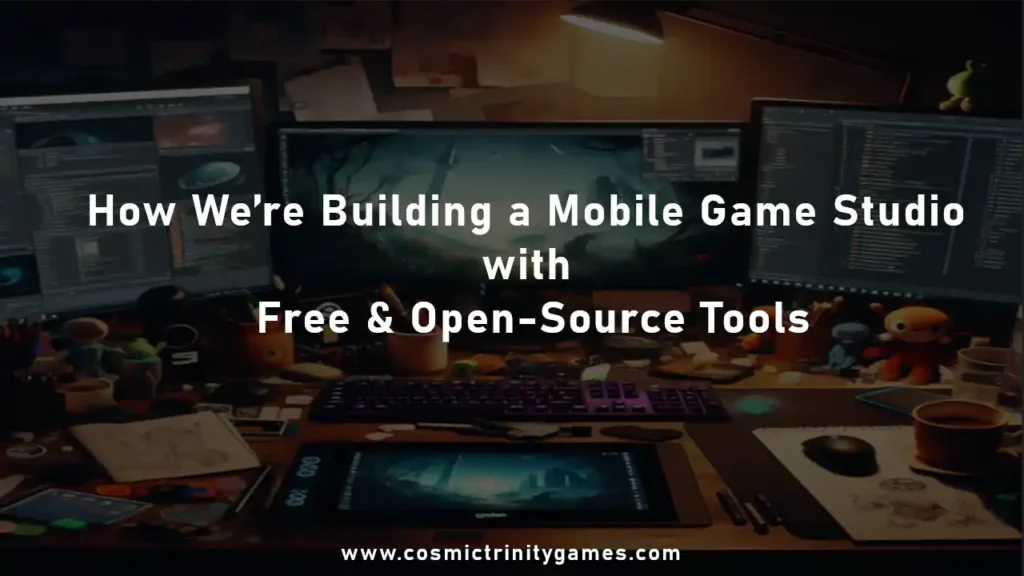Introduction: A Studio Built on Passion & Practicality
At Cosmic Trinity Games, we’re two indie developers with a shared dream — to build snack-sized mobile games that people can enjoy on-the-go, whether they’re commuting by metro, waiting for a bus, or killing time before an appointment.
Our journey began not with a massive budget or a big publisher deal — but with curiosity, determination, and a powerful set of free and open-source tools for game development.
If you’re wondering how to make a mobile game for free, or which free game development tools to use when you’re starting out, you’re in the right place.

Table of Contents
Why We Chose Open-Source & Free Tools
Budget Constraints
Not sure if it’s a common issue among all indie developers or just a challenge unique to Cosmic Trinity, but in the beginning, we didn’t want to spend all our savings creating our first game. As an indie studio, we simply couldn’t justify the cost of expensive licences or subscriptions. Our focus is on crafting fun, fast, and replayable games — not getting bogged down by overheads.
Flexibility & Freedom
As game developers, we often turn to paid software to boost productivity and access better support. However, as the founders of a mobile game studio, we realised it’s not truly necessary to rely on such tools in the early stages. That’s where open-source software comes in — offering the freedom to tweak, adapt, and customise as we grow.
Skill Over Spend
We believe skill is more valuable than software. Our stack proves that you can create quality prototypes and commercial-ready games using only free tools — if you put the work in.
Top Free Game Development Tools We Use
Below are the core tools we use at Cosmic Trinity Games, organised by category. These have been our primary choices since starting our indie mobile studio. As we grow, we plan to explore more areas within the open-source ecosystem.
Project Research & Organisation
- Google Search for tutorials, tool discovery, and competitor research.
- Google Docs & Sheets for documentation, design notes, and progress tracking.
- Google Drive to manage assets and collaborate in real-time.
Pro Tip: We created a separate Google account just for the studio. This keeps our recommendations, ads, and YouTube suggestions focused only on game development.
Art & Design Tools
Krita
We use Krita to create UX mockups, concept art, and quick level designs. It’s free, open-source, and comes loaded with a versatile brush system — perfect for game UI prototyping.
GIMP
GIMP is our go-to for:
- Social media graphics
- Spritesheet Slicing
- PSD manipulation
- Texture editing & normal map generation
For vector graphics, logo creation, and editing scalable assets, Inkscape has been a vital part of our creative toolkit — especially for clean, high-resolution UI elements.
Game Engines
Unity (Main Engine)
After prototyping in Godot, we moved our production to Unity. Why?
- Faster prototyping for mobile
- Large ecosystem of assets and plugins
- Better debugging experience
- More stable cross-platform build support
We’re currently developing our first 4–6 titles using Unity.
Godot (Prototype Engine)
Initially, we built several prototypes in Godot. It’s lightweight, beginner-friendly, and an excellent alternative to Unity for mobile and 2D-focused games. However, we soon realised that certain features required us to switch to Unity — and eventually, we made a complete transition. It was a tough decision, as it meant letting go of our dream to develop a game entirely using open-source tools.
A detailed post on why we switched from Godot to Unity is coming soon — stay tuned.
Version Control & Collaboration
Git + GitHub
We use Git for version control and GitHub to host our repositories. With only two devs on the team, it’s more than enough.
We avoided premium Unity-specific solutions and stuck with tools that scale freely with our workflow.
Mistakes We Made (So You Don’t Have To)
This section is especially important for all my friends who are just starting to build a mobile game studio. Reading this may help you avoid some common mistakes. Every indie developer’s journey has its challenges — here’s what we’ve learnt along the way:
Choosing the wrong engine first
We jumped into Godot too quickly. After playtesting, Unity turned out to be a better fit for our needs. Lesson: Don’t rush tool selection. Prototype, test, and decide based on your game’s actual needs.
Over-investing in fancy tools
There’s no need to buy expensive software early on. We spent time learning and mastering free tools first — that paid off better than any premium tool we couldn’t fully use.
Over-complicating project management
We initially felt pressured to use full-stack project management tools. In the end, Google Sheets did the job just fine for a two-person team.
Summary: Our Open-Source Game Dev Stack
Here’s a quick recap of the best free game dev tools we’re using at Cosmic Trinity Games:
| Category | Tool(s) Used |
| Game Engines | Unity, Godot |
| 2D Art & Design | Krita, GIMP, Inkscape |
| Project Management | Google Sheets, Docs, Drive |
| Version Control | Git + GitHub |
| Audio (Future Tools) | Audacity |
These tools help us build, iterate, and ship games — all without breaking the bank.
Final Thoughts & Call to Action
You don’t need a massive budget to start making games.
With the right free tools, dedication, and a bit of creativity, you can build your own indie studio — just like we are doing at Cosmic Trinity Games.
Want to follow our journey?
Subscribe to our updates or follow us on social media for future posts like:
- Why We Switched from Godot to Unity
- How Much It Costs to Start an Indie Studio
- Our Favourite Free Tools for Game Marketing
- Check Coming Soon Page for TimeLine
What free tools do you use for game development? Let us know in the comments — we’d love to learn from fellow devs.